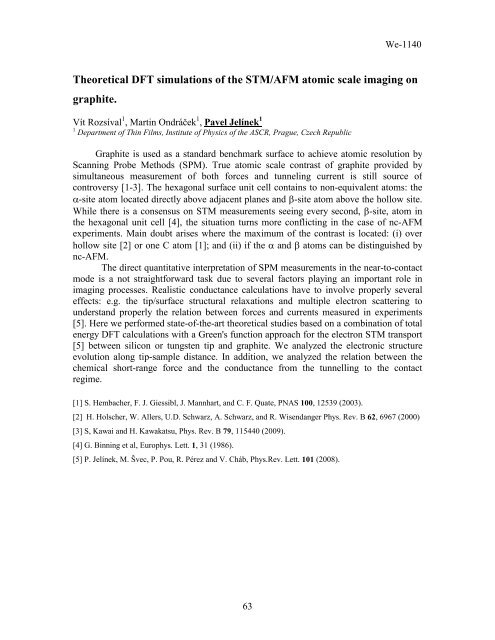Noncontact Atomic Force Microscopy - Yale School of Engineering ...
Noncontact Atomic Force Microscopy - Yale School of Engineering ...
Noncontact Atomic Force Microscopy - Yale School of Engineering ...
Create successful ePaper yourself
Turn your PDF publications into a flip-book with our unique Google optimized e-Paper software.
We-1140<br />
Theoretical DFT simulations <strong>of</strong> the STM/AFM atomic scale imaging on<br />
graphite.<br />
Vít Rozsíval 1 , Martin Ondráček 1 , Pavel Jelínek 1<br />
1 Department <strong>of</strong> Thin Films, Institute <strong>of</strong> Physics <strong>of</strong> the ASCR, Prague, Czech Republic<br />
Graphite is used as a standard benchmark surface to achieve atomic resolution by<br />
Scanning Probe Methods (SPM). True atomic scale contrast <strong>of</strong> graphite provided by<br />
simultaneous measurement <strong>of</strong> both forces and tunneling current is still source <strong>of</strong><br />
controversy [1-3]. The hexagonal surface unit cell contains to non-equivalent atoms: the<br />
α-site atom located directly above adjacent planes and β-site atom above the hollow site.<br />
While there is a consensus on STM measurements seeing every second, β-site, atom in<br />
the hexagonal unit cell [4], the situation turns more conflicting in the case <strong>of</strong> nc-AFM<br />
experiments. Main doubt arises where the maximum <strong>of</strong> the contrast is located: (i) over<br />
hollow site [2] or one C atom [1]; and (ii) if the α and β atoms can be distinguished by<br />
nc-AFM.<br />
The direct quantitative interpretation <strong>of</strong> SPM measurements in the near-to-contact<br />
mode is a not straightforward task due to several factors playing an important role in<br />
imaging processes. Realistic conductance calculations have to involve properly several<br />
effects: e.g. the tip/surface structural relaxations and multiple electron scattering to<br />
understand properly the relation between forces and currents measured in experiments<br />
[5]. Here we performed state-<strong>of</strong>-the-art theoretical studies based on a combination <strong>of</strong> total<br />
energy DFT calculations with a Green's function approach for the electron STM transport<br />
[5] between silicon or tungsten tip and graphite. We analyzed the electronic structure<br />
evolution along tip-sample distance. In addition, we analyzed the relation between the<br />
chemical short-range force and the conductance from the tunnelling to the contact<br />
regime.<br />
[1] S. Hembacher, F. J. Giessibl, J. Mannhart, and C. F. Quate, PNAS 100, 12539 (2003).<br />
[2] H. Holscher, W. Allers, U.D. Schwarz, A. Schwarz, and R. Wisendanger Phys. Rev. B 62, 6967 (2000)<br />
[3] S, Kawai and H. Kawakatsu, Phys. Rev. B 79, 115440 (2009).<br />
[4] G. Binning et al, Europhys. Lett. 1, 31 (1986).<br />
[5] P. Jelínek, M. Švec, P. Pou, R. Pérez and V. Cháb, Phys.Rev. Lett. 101 (2008).<br />
63















